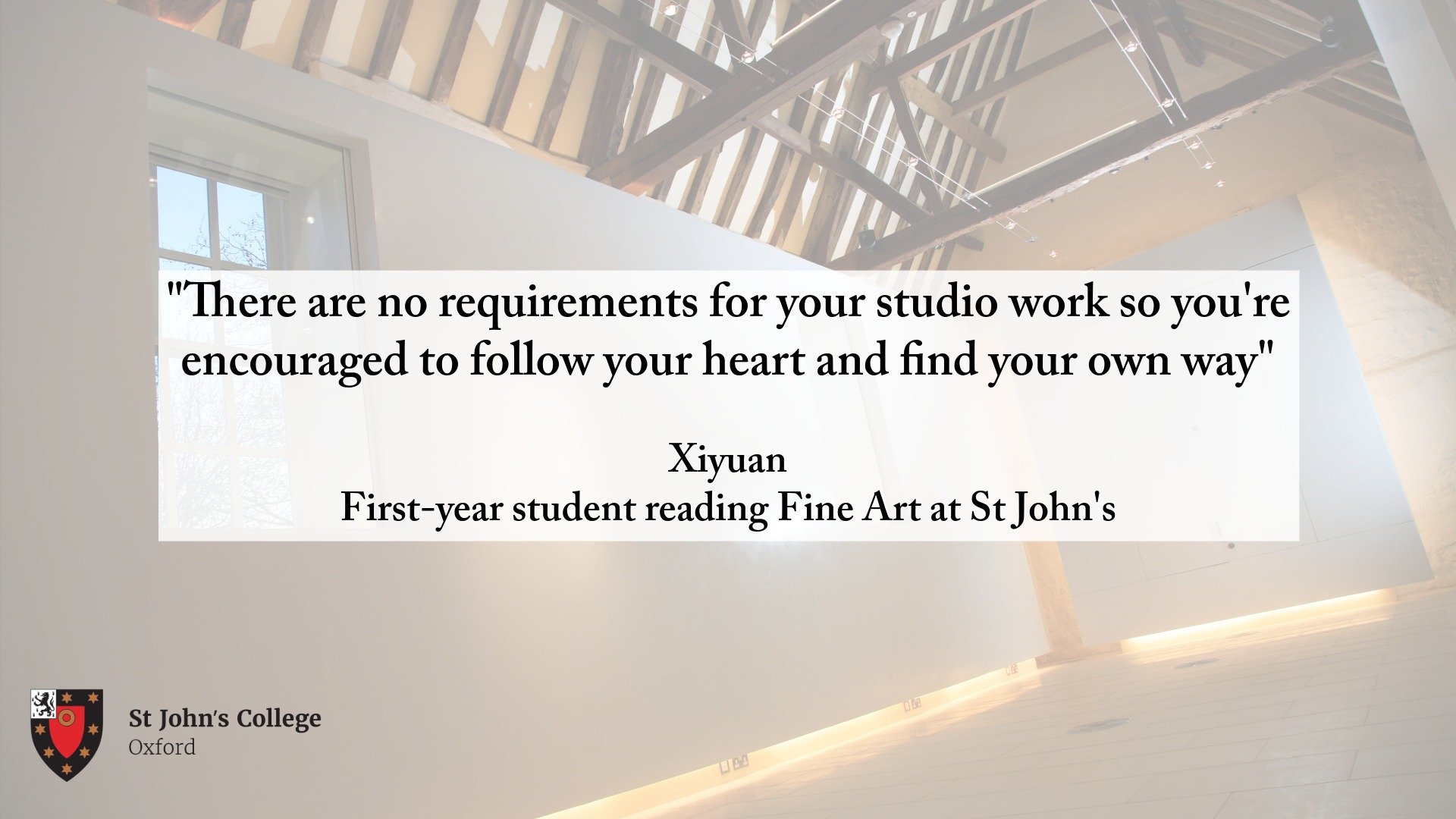Fine Art

- On average, St John's accepts 1 undergraduate Fine Art student per year
- In your portfolio, we will be looking for artwork that goes beyond fulfilling school assignments, to demonstrate your own unique set of curiosities, ambitions, and energies.
- The entry requirements for this course are determined by The Ruskin School of Art.
- More information about applying to study Fine Art at Oxford can be found on the Ruskin’s website.
- General advice about applying to St John’s can be found here.
- Because of the small and studio-based nature of the subject, Fine Art students take their courses at the Ruskin School of Art, where studio practice and theory are dynamically intertwined.
- St John's fine artist students are part of a community where they can widen an already multi-disciplinary dialogue, conversing with fellow students from nearly every academic field, from literature to neuroscience.
- We offer grants that go towards the cost of arts materials.
- Our undergraduates are part of a small but close-knit group of artists at St John's, supported by tutors in fine art and art history, and by the lively presence of Fine Art DPhil students.
- The artistic life of the college is further enlivened by yearly artists in residence, and sound artists in residence, working across many media, and who live in college for a term, and engage directly with students and hold talks and workshops. Such artists have included Uriel Orlow, Anna Barham,Matmos, Rawz, Ciara Phillips, Robert Beavers, and Corin Sworn, while Turner Prize winner Elizabeth Price was previously a Helen Chadwick Fellow. Heather Agyepong will join in 2025.
- The Dolphin Gallery is run by the St John's Arts Officer, providing an experimental space open to bookings by all Ruskin students, while the Barn in the Kendrew Quadrangle hosts ambitious exhibitions, as well as acting as a space for workshops and activities in art, film, music and drama.
- Our graduates have been successful in many fields, as fine artists, curators, critics, writers, teachers, designers, and directors in the creative industries. Many pursue postgraduate degrees.
- Graduates will leave college as independent artists, able to conceive, think through, and realise complex creative projects. These transferrable skills will equip them to continue making art, or to tackle other forms of critical and imaginative work.
Watch a St John's student talking about studying Fine Art:
Learn more about reading Fine Art at St John's through the student profiles below.
Ruouzhou is a second-year student reading Fine Art

What A Levels (or equivalent) did you take?
History of Art, Fine Art, Mathematics, Physics (AS level), EPQ
What inspired you to study at Oxford?
I was initially interested in applying to Oxford because of the access to the University’s renowned library and archival resources, as well as a wide range of museums such as the Ashmolean and the Natural History Museum. Meanwhile, the wide range of courses the University provides also enables interdisciplinary dialogues that I thought might broaden my experimental approaches in art-making.
What do you like about studying at St John's?
Due to the BFA Fine Art course’s unique curriculum, I do not have any tutorials or academic lectures within the college, which differs from almost all the other courses. Hence, college is more of a space for me to spark interdisciplinary dialogues with people from various academic fields, which in turn enriches my own artistic practice, and sparks potential collaborations with peers from other disciplines. Moreover, the college’s well-stocked library provides numerous resources for studying the historiography of visual culture, and beyond (I particularly enjoy the window seats overlooking the garden in the upper reading room!)
What aspects of your degree do you find particularly enjoyable or fulfilling?
One of the many things I enjoyed studying at the Ruskin, is that there is no obligation to commit to a singular pathway or mode of art-making. Instead, we are encouraged to experiment with all kinds of mediums to form our own artistic languages. Withal, the relatively small cohort enables intensive peer dialogues and reflection through the one-to-one tutorial system. Beyond the rigorous studio practice, the BFA Fine Art course also offers a unique human anatomy course for the first years. The invaluable opportunity to enter and make observational drawings at the University’s Dissection Room, have provided me with an interdisciplinary perspective on the potential intersection of artistic sensitivity with anatomical expertise. Personally, I find the theoretical component the most enjoyable, which emphasises the engagement with the contemporary theory of visual culture. This massively helps me to situate my artistic practice within a wider critical framework, while examining the role of art, gallery, and even the art markets in various socio-political contexts
How does life in College compare to what you originally envisioned?
Before arriving at St John’s, I envisioned college life similar to my previous boarding experience in sixth-form college, and it turned out to be massively different. There is certainly less sense of regulated ‘guidance’ and a higher degree of personal freedom. In College, it feels more like a hybrid space that blends rigorous academic studies with social activities, bringing people from all kinds of backgrounds and courses together to form a vibrant community. The various facilities available at St John’s, ranging from the café, gyms, and even a gallery space for curatorial purposes, all combine to support daily life both academically and socially.
What do you do in your spare time?
I love wandering in St John’s garden when it’s sunny, and wishing the College cats would grace me with their presence on their venture across the College.
What advice would you give to someone hoping to study at Oxford?
One piece of advice would be to read widely and be experimental. Art-making does not have to be guided by a pre-determined rationale aimed to produce a ‘polished’ piece, but often the willingness and commitment to experimentation may lead to unexpected surprising results. If you are interested in the History and Theory of Visual Culture, the Ruskin is a perfect place for you to further examine the interrelationship between the practical and the theoretical.


